We love Leonardo da Vinci because...
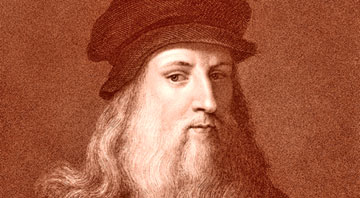 |
Leonardo
(Credit: Georgios Kollidas / Alamy) |
Leonardo da Vinci was born on April 15 day in 1452.Not only a
talented artist, he also contributed to the fields of anatomy,
engineering, biology, mathematics and architecture. His inventions and
discoveries were way ahead of his time. As Leonardo said: "The noblest
pleasure is the joy of understanding." Commemorating his birthday, BBC
Culture asked its readers across the globe to share their favourite
works by Da Vinci and explain why they love them. And this is what they
shared.
Lady with an Ermine
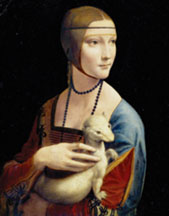
(Credit: Lady with an Ermine/Leonardo da Vinci/Wikipedia)
Submitted by Alexandra Degtereva from Moscow, Russia: Lady with an
Ermine is one of Leonardo's most famous paintings, however some question
whether it was made by him at all. The reconstruction of the painting's
layers shows that there were three different versions of it and they
didn't all include the ceremonial animal. It is believed that this is a
portrait of a young lady called Cecilia Gallerani who was the mistress
of the Duke of Milan, Leonardo's main patron at that time. The duke was
nicknamed "the white ermine".
The Virgin and Child with St Anne and St John the Baptist
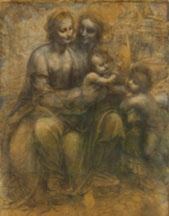
(Credit: The Virgin and Child with St Anne and St
John the Baptist/Leonardo da Vinci/Wikipedia)
Submitted by Maria Papadopoulou from Greece: "The Virgin and Child
with St Anne and St John the Baptist (also known as The Burlington House
Cartoon) is a full-size preparatory study for a painting. It was drawn
in charcoal with chalk highlights and never translated into a painting.
The Virgin Mary sits on the lap of her mother St Anne, while Christ
blesses his little cousin St John the Baptist. The finger that St Anne
points to heaven is a symbol of Christ's future destiny.
The Annunciation

(Credit: The Annunciation/Leonardo da Vinci/Wikipedia)
Submitted by Tanja Skrgatic from Zagreb, Croatia: "It's my personal
favourite because there are so many different versions of the same theme
in the art history.
I personally like this version the most because I think it's the
strongest and most remarkable. Just the way the angel is kneeling... No
need for words!"
The Annunciation shows the moment when the angel Gabriel appears
before Mary, while the enclosed garden symbolises her virginity.
There are two versions of this painting - one in the Uffizi gallery
in Florence and the other one in the Louvre. The first one is more
likely to be Leonardo's, even though it has some technical flaws.
However, it was painted when the artist was still young.
Study of Arms and Hands
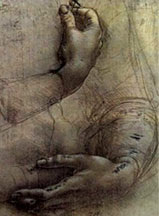
(Credit: Study of Arms and Hands/Leonardo da Vinci/Wikipedia)
Submitted by Kristian Bruun from Berlin, Germany: Study of Arms and
Hands is a sketch by Leonardo da Vinci, probably a preliminary study for
his painting Lady with an Ermine. It was drawn in chalk.
La Scapigliata
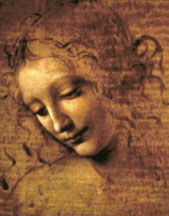
(Credit: La Scapigliata/Leonardo da Vinci/Wikipedia)
Submitted by Fani Tsoukala from Athens, Greece: "She is like a 'panthea'.
The way she bends her head and the look on her face, breathtaking!" La
Scapigliata (sometimes referred to simply as Female Head) shows a woman
with uncombed hair, but so much more as well: the natural beauty and
power of a woman.
Anatomist drawings
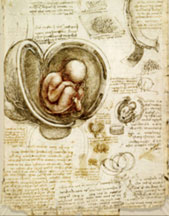
(Credit: Royal Collection, Her Majesty Queen
Elizabeth II)
Submitted by Lana VB from Croatia: "I love his anatomy drawings. They
are so precise and realistic. He was far ahead of his time."Leonardo was
a pioneer in understanding the human anatomy. His drawings of the human
body stayed among his private papers and remained unknown to the public
for nearly 400 years after Da Vinci's death.
This large drawing of an embryo within a uterusis one of his many
anatomist drawings - he also studied bones, genitalia, the principal
organs and other parts of the human body.
St John the Baptist

(Credit: St John the Baptist/Leonardo da Vinci/Wikipedia)
Submitted by Saloni Tiwari from India: St John the Baptist is
Leonardo's last painting and it was still in his possession when he
died. The pointing gesture, which this artist used extensively in his
work, suggests the importance of salvation through baptism. Even though
St John was usually portrayed by other artists as gaunt, living in a
desert on a diet of locusts and honey, Leonardo depicted him in a
feminine way with an enigmatic smile similar to that of Mona Lisa.
The Virgin of the Rocks

Submitted by Karen Howard-Goldsmith from the UK: "I love this one,
but actually I couldn't really pick a favourite... what a master talent!
So ahead of his time."The Virgin of the Rocks is actually two paintings
of the same subject. The one on the left is the first version and hangs
in the Louvre, while the one on the right is in the National Gallery in
London.
They are both nearly two metres high and painted in oil. While the
Louvre version is believed to be the one Leonardo made first, the other
is still a matter of debate. The studies of botany in the National
Gallery picture suggest that the plants were painted inaccurately -
which isn't something Leonardo would do, considering his precision and
faithfulness to nature. |

